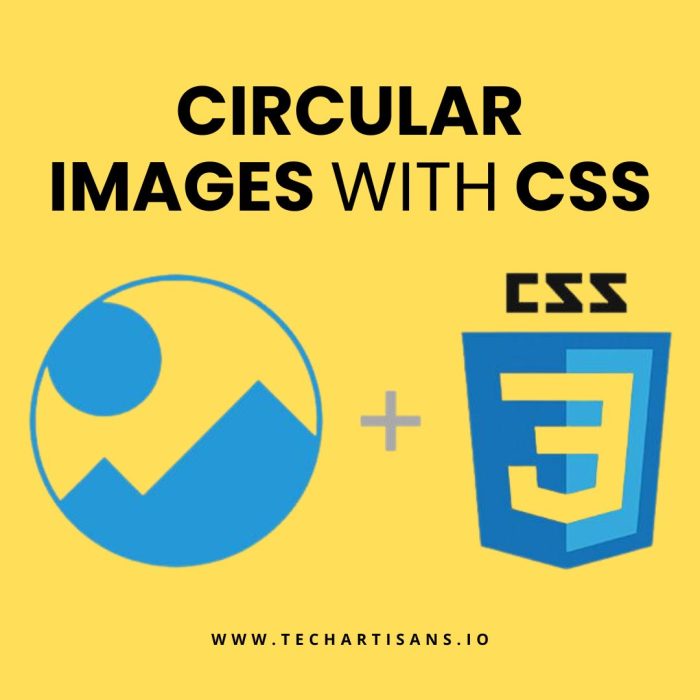In the constantly changing world of web design, it’s all about those little details. Everything, from the colors you use to the images you pick, plays a vital role in making a website that truly represents your brand. Using CSS to create round pictures, rather than the usual square or rectangle, is becoming increasingly popular for that extra visual appeal. A ‘css circle image’ adds a contemporary twist to your website’s visuals and exudes minimalism and sophistication, instantly capturing your visitor’s attention. Let’s explore ‘CSS circular images’ and give your website a fresh look.
Circular Images with CSS
Let’s unlock the power of CSS and learn how to create attractive, circular images to enhance your business’s online aesthetic appeal.
Why Use Circular Images?
Incorporating circular images in web design, powered by the simplicity of CSS, is not merely about following a trend; it’s about leveraging the psychological impact of shapes on users’ perceptions and experiences.
Importance of Shapes in Web Design
Shapes are powerful design tools. They convey meanings, evoke emotions, set the mood, and influence purchasing decisions. In web design, the use of shapes can significantly impact user experience. For instance, circular shapes, such as a ‘css circle image,’ often symbolize unity and completeness, giving a more relaxed and friendly impression. Conversely, square or rectangular shapes are perceived as stable and reliable.
Benefits of Incorporating Circles
Using circular images in your website design with ‘circular image CSS’ adds a fresh, modern touch, guides users, and creates a friendly, engaging vibe. Secondly, circular images show the user’s eye around the screen in a natural, smooth motion. Lastly, circles are perceived as organic and human-friendly shapes, making your website appear more approachable and engaging to visitors.
Basic Method: Using Border-radius
Let’s introduce you to the basic method of creating circular images using CSS, the `border-radius` property. This approach is straightforward, easy to implement, and compatible with all modern web browsers, making it an excellent starting point for beginners.
Explanation of The Border-radius Property
The `border-radius` property in CSS allows you to add rounded borders to an element. By setting this property to 50%, we can transform a square image into a perfect circle. It turns each image’s four corners into quarter-circles, creating a seamless circular appearance. This simple yet powerful CSS property is the key to creating ‘css circle images’ in your web design.
Step-by-step Guide
Here’s a quick guide to creating a circular image using the `border-radius` property in CSS:
- Start by selecting your image using its CSS selector.
- Apply the `border-radius` property to your image selector in your CSS file.
- Set the value of the `border radius` to 50%.
- Save your changes and refresh your webpage to see the transformation of your image into a perfect ‘css circle image.’
Code Examples and Visual Representations
Here’s an example of the CSS code:
“`css
img {
border-radius: 50%;
}
“`
In this code, the ‘img’ selector targets all images on your webpage. The `border-radius: 50%;` line transforms these images into circular shapes. Visually, an originally square image with defined borders will now appear as a perfect circle, showcasing the power of ‘circular image CSS.’
Advanced Techniques
Explore these advanced methods for creating a ‘css circle image.’
Using Background-image For Circular Images
Using the `background-image` property in CSS, you can effectively set images as the background of any HTML element and craft them into circular shapes. This method is particularly useful if the image is decorative rather than a key part of the content. By simply applying a `border-radius: 50%` to the element with a background image, you can create a ‘css circle image’ while retaining control over the image’s size and position.
Responsive Circular Images
Creating ‘css circle images’ responsive and adaptable to different screen sizes is crucial in the era of diverse digital devices. This can be achieved by using the `max-width` property in CSS. By setting `max-width: 100%;`, your images will scale down if they have to, but never scale up to be larger than their original size.
The Clip-path Method
CSS’s clip-path property is a cool way to make circular images and more. It’s like cutting out shapes from paper. To make a circle with it, you use the circle() function, which lets you control the size and position of the ring processes. It’s more flexible than border-radius and can create all sorts of shapes, not just circles.
Responsive Circular Images with CSS
In the following section, we delve into the concept of ‘Responsive Circular Images with CSS.’ As the digital landscape grows more diverse, ensuring your ‘css circle images render correctly across all device types is essential to maintaining consistency in your website’s visual appeal. Let’s explore how CSS can make your circular images responsive, thus ensuring a seamless user experience regardless of the device used.
Importance of Responsive Design
Responsive design is super important in website development today. It ensures your website looks great on any device and that your ‘css circle images render correctly across all device types, whether a big computer screen or a small phone. With so many people using different devices, responsive design keeps your site user-friendly and good-looking, regardless of screen size.
Creating Responsive Circular Images with CSS
To create responsive ‘circular image CSS,’ set your image’s `max-width` property to 100%. This ensures your image scales down on smaller screens. Then, maintain equal width and height values for your image and apply `border-radius: 50%` to retain a circular shape across all device sizes.
Additional Tips and Tricks
Unveil additional tips and tricks to further refine your CSS skills, specifically focusing on optimizing the usage of ‘css circle image.’ These hints will enhance your webpage design and effectively streamline your coding process.
Using Online Tools for Cropping and Editing
Numerous online tools are available, like Canva and Adobe Spark, that can significantly simplify the process of cropping and editing your ‘css circle image.’ These platforms offer user-friendly interfaces and pre-set shapes, including circles, that allow you to get the desired shape of your image without any coding. This way, you can easily create and edit circular images before applying CSS, ensuring a perfect fit for your website’s design.
Enhancing Circular Images with Text Overlay
Adding text over your ‘css circle image’ can enhance visual appeal and provide context. To accomplish this, wrap your image and text in a `div` element. Then, position the reader over the image using `position: absolute;` and align it as desired. Remember to set `position: relative;` on the parent `div` to ensure correct positioning. This technique can help you create dynamic and informative ‘circular image CSS’ effects on your site.
Common Issues and Solutions
Let’s explore some common issues and their solutions when working with ‘css circle image.’
Common Challenges in Creating Circular Images
One common problem when creating a ‘css circle image’ is that the image becomes an oval shape if its original width and height differ. To rectify this, maintain equal values for the width and height of the picture. Another issue is image distortion on different screen sizes. This can be resolved using responsive design principles and setting the `max-width` property to 100%, ensuring seamless scaling of your ‘circular image CSS’ across varying device screens.
Tips For Ensuring the Best Visual Output
For the best visual output, always choose high-quality images for your ‘css circle image’. Lower-resolution images can appear pixelated when resized. Also, maintain an equal aspect ratio for the width and height to keep the circle’s shape consistent. Lastly, use CSS properties like `object-fit` to control how the image fits within its container.
Conclusion
In conclusion, mastering the art of creating ‘css circle image’ can significantly elevate the design of your website. To make eye-catching circular images, it’s important to grasp techniques like ‘border-radius’ and ‘clip-path’ and to recognize the significance of responsive design. Additionally, online tools for cropping, adding text, and troubleshooting can boost your ‘circular image CSS’ abilities. If you’re a business owner, mastering these methods will elevate your website’s look and enhance the user experience.
Further Reading and Resources
For deeper understanding and hands-on practice, consider these additional resources. W3Schools offers a comprehensive guide to creating ‘css circle image.’ Similarly, CSS Tricks is an excellent source for advanced CSS techniques. For video tutorials, Codecademy’s YouTube Channel is a fantastic place to start. These resources will not only enhance your ‘circular image CSS skills but also broaden your overall web development knowledge. Happy learning!







